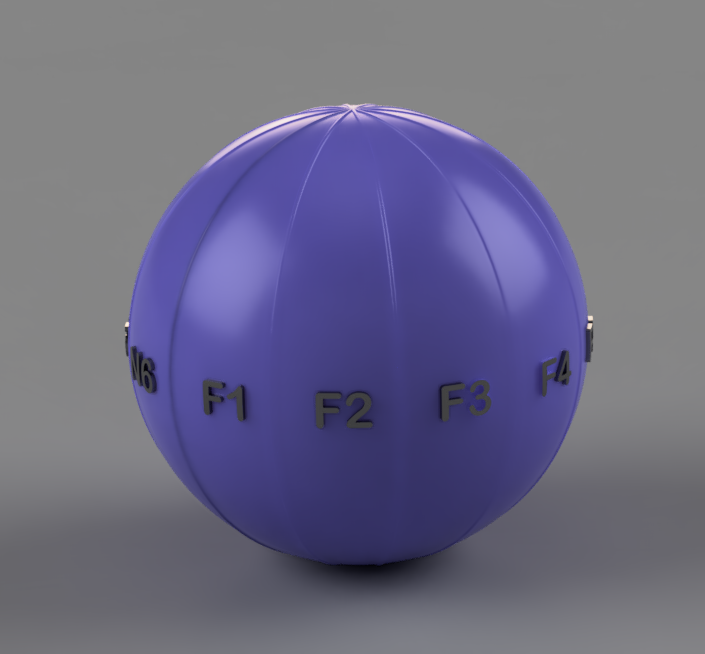Interactive Moon Phase Model

Overview
I developed an interactive 3D model to help students visualize and understand the phases of the Moon through accurate spatial relationships between the Sun, Earth, and Moon.
The model allows learners to explore how the Moon’s illumination changes as it orbits Earth and how these changes create the observed lunar phases. Students can manipulate viewing angles and orbital positions to see each phase from both Earth’s perspective and space.
Used in astronomy labs and integrated with Canvas LMS, this 3D model provides a clear, hands-on way to grasp one of the most foundational concepts in Earth and space science.
Project Design & Purpose
This interactive was built as a teaching tool for labs and LMS platforms like Canvas, where students can manipulate the system and immediately see cause–effect relationships. It’s designed to align with NGSS space science (MS‑ESS1, HS‑ESS1) and to strengthen spatial reasoning through accurate, visual-first explanations.
Learning Goals
- Develop accurate conceptions of lunar phases and geometry (Sun–Earth–Moon alignment)
- Strengthen proportional/spatial reasoning by switching between space and Earth perspectives
- Apply systems thinking to explain observed illumination from orbital position
- Dispel common misconceptions (Earth’s shadow causes phases; Moon emits light)
The Moon Phase Challenge
Students often memorize phase names without understanding why phases occur. Common misconceptions include:
- “Earth’s shadow causes phases” (actually that’s a lunar eclipse)
- “The Moon produces its own light”
- “The Moon only reflects sunlight during full moon”
- “Phases are caused by clouds or atmospheric effects”
This model helps students build correct mental models by showing the geometry of Earth, Moon, and Sun together.
Interactive Features
Dual Perspective View
- Space View: Shows Earth, Moon, and Sun positions from above the orbital plane
- Earth View: Shows what an observer on Earth sees at that moment
- Switch between perspectives to understand the connection
Time Control
- Play/pause animation to see the Moon orbit Earth
- Speed controls to slow down or speed up orbital motion
- Scrub timeline to jump to specific phases
- 29.5-day lunar cycle accurately represented
Phase Labels & Information
- Names for each major phase (New, Waxing Crescent, First Quarter, etc.)
- Percentage of Moon illuminated
- Approximate time phase rises and sets
- Days since new moon
Interactive Exploration
- Drag the Moon to any position in its orbit
- See real-time updates of what Earth observers would see
- Click on phase names to jump to that configuration
- Toggle labels and annotations on/off
Educational Value
Spatial Reasoning
Students develop three-dimensional thinking by rotating between perspectives and understanding how position in space relates to appearance from Earth.
Cause and Effect
By moving the Moon themselves, students discover the causal relationship between orbital position and observed phase—they’re not just memorizing, they’re understanding.
Misconception Correction
The model explicitly shows sunlight always illuminating half the Moon, addressing the “Moon makes its own light” misconception. It shows Earth’s shadow separately during eclipse scenarios.
Lesson Plan Integration
Introduction Activity (15 min)
Students explore the model freely, discovering patterns on their own before formal instruction.
Guided Exploration (20 min)
Teacher guides class through specific positions:
- “Move the Moon between Earth and Sun—what do we see?”
- “What happens when Moon is opposite the Sun?”
- “Why do we sometimes see the Moon during daytime?”
Assessment Activity (10 min)
Students screenshot specific phases from the model and label them, or predict what phase will occur given a specific date.
Extension: Eclipses
Add solar and lunar eclipse scenarios by adjusting orbital plane tilt, showing why eclipses are rare.
Canvas LMS Integration
Embed directly in Canvas pages or link as an external resource. Works seamlessly on interactive whiteboards, tablets, and computers. No login or installation required.
Technical Implementation
Accurate Astronomy
- Lunar orbital period: 29.53 days (synodic month)
- Correct phase progression and timing
- Scientifically accurate illumination geometry
- Optional: include orbital eccentricity and libration
Performance Optimized
- Smooth animation on all devices
- Responsive design for mobile, tablet, desktop
- Lightweight code for quick loading
- Works offline once loaded
Accessibility
- Keyboard controls for all functions
- Screen reader descriptions of phases
- High-contrast mode for visual impairments
- Touch-friendly controls for tablets
Student Feedback
“I finally understand why we see different moon shapes! Seeing it from space and from Earth at the same time made it click.” — 8th grade student
“This should be in every science textbook. Way better than the diagrams.” — High school astronomy student
Future Enhancements
Planned additions:
- Tidal effects visualization (spring tides vs. neap tides)
- Eclipse predictor and simulation
- Moon rise/set time calculator
- Apparent size variation (apogee vs. perigee)
- Historical/future phase calculator
Related Tools
For Educators
If you’re interested in using this model in your classroom or have suggestions for improvements, please contact me at stramark@gmail.com.
Download & Access
Live Demo: [Coming soon - hosted version]
Standalone Download: [HTML file for offline use]
Canvas-Ready Embed Code: Available upon request